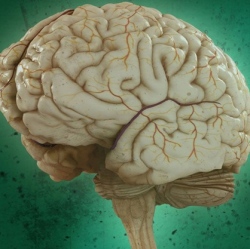
A research assistant at the Harvard Medical School-affiliated McLean Hospital noticed an intriguing pattern. One of her tasks was to escort study participants to and from an MRI machine where they received brain scans. All of the participants had bipolar disorder and were depressed;
The scans involved an experimental form of MRI that measured the effect of medication changes on their brain chemistry. “The research assistant noticed that people came out of the MRI saying, ‘I feel much better,’” remembers Michael Rohan, an imaging physicist at McLean and lecturer at Harvard Medical School (HMS). The assistant shared her observations with the lab director, who consulted Rohan because of his expertise in the biological effects of electromagnetic fields (see “Magnetically Lifted Spirits,” May-June 2004, page 18). Why, they wondered, might this type of MRI trigger a sudden lift in mood?
Rohan immediately zeroed in on one particular waveform within the MRI because it pulsed at a speed and strength that he suspected could affect neuronal activity. He built a small prototype that produced the waveform, and colleagues then conducted an animal study frequently used to test antidepressant medications. “Rats who have been given an antidepressant are more likely to swim or climb, instead of just floating and resting,” Rohan explains, and the rats exposed to his device swam and climbed more than the control animals. That suggested he had identified something significant.
He then set to work designing a device to administer this low-frequency magnetic stimulation (LFMS) to humans, and received review-board permission to test it. The resulting machine looks a little like a miniature MRI machine, but is just 14 inches wide and can sit on a tabletop. The patient lies on a gurney, head positioned on a headrest; the device then slides down over the top of the head to about the eyebrows, “so that patients can see out,” Rohan explains. “We wanted people to feel very comfortable.”
In an article published this past summer in Biological Psychiatry, Rohan and his colleagues, including senior author Bruce M. Cohen, Robertson-Steele professor of psychiatry, describe their study of 63 people diagnosed with either major depression or bipolar disorder. People received either one 20-minute treatment with LFMS or a sham procedure, and took standard mood-assessment tests before and after treatment.
Both groups experienced immediate and significant improvement in mood: people in the placebo group showed a five-point improvement on a 17-point scale, while the treatment group had an eight-point improvement. That suggested, Rohan says, that researchers managed to “capture and separate out” the placebo effect. “People who come to McLean Hospital and get to try new technology feel better just because they walked in the door,” he says. Once the placebo effect has been stripped away, the remaining three-point change is similar to the improvements many people see after taking an antidepressant medication for six weeks.
